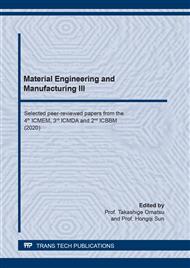[1]
Kassardjian, A., P.I. Shintaku, and N.A. Moatamed, Expression of immune checkpoint regulators, cytotoxic T lymphocyte antigen 4 (CTLA-4) and programmed death-ligand 1 (PD-L1), in female breast carcinomas. PLoS One, 2018. 13(4): p. e0195958.
DOI: 10.1371/journal.pone.0195958
Google Scholar
[2]
Kitano, A., et al., Tumour-infiltrating lymphocytes are correlated with higher expression levels of PD-1 and PD-L1 in early breast cancer. ESMO Open, 2017. 2(2): p. e000150.
DOI: 10.1136/esmoopen-2016-000150
Google Scholar
[3]
Chiu, Y.M., et al., PD-1 and PD-L1 Up-regulation Promotes T-cell Apoptosis in Gastric Adenocarcinoma. Anticancer Res, 2018. 38(4): pp.2069-2078.
DOI: 10.21873/anticanres.12446
Google Scholar
[4]
Shi, F., et al., PD-1 and PD-L1 upregulation promotes CD8(+) T-cell apoptosis and postoperative recurrence in hepatocellular carcinoma patients. Int J Cancer, 2011. 128(4): pp.887-96.
DOI: 10.1002/ijc.25397
Google Scholar
[5]
Brunet, J.F., Denizot, F., Luciani, M. F. et al, A new member of the immunoglobulin superfamily–CTLA-4. Nature, 1987. 328.
DOI: 10.1038/328267a0
Google Scholar
[6]
Kumar, P., P. Bhattacharya, and B.S. Prabhakar, A comprehensive review on the role of co-signaling receptors and Treg homeostasis in autoimmunity and tumor immunity. J Autoimmun, 2018. 95: pp.77-99.
DOI: 10.1016/j.jaut.2018.08.007
Google Scholar
[7]
Hamanishi, J., M. Mandai, and I. Konishi, Immune checkpoint inhibition in ovarian cancer. Int Immunol, 2016. 28(7): pp.339-48.
DOI: 10.1093/intimm/dxw020
Google Scholar
[8]
Banchereau J, P.A., et al, Immune and clinical responses in patients with metastatic melanoma to CD34(+) progenitor-derived dendritic cell vaccine. Cancer research, 2001. 61: p.6451–6458.
DOI: 10.3410/f.1001806.12205
Google Scholar
[9]
Geiger JD, H.R., et.al, Vaccination of pediatric solid tumor patients with tumor lysate-pulsed dendritic cells can expand specific T cells and mediate tumor regression. Cancer Res, 2001. 61: p.8513–8519.
Google Scholar
[10]
Nair SK, M.M., Boczkowski D, Cumming RI, Vasovic L, Gilboa E, Lyerly HK, Induction of tumor-specific cytotoxic T lymphocytes in cancer patients by autologous tumor RNA-transfected dendritic cells. Ann Surg, 2002. 235: p.540–549.
DOI: 10.1097/00000658-200204000-00013
Google Scholar
[11]
Steele JC, R.A., et.al, Phase I/II trial of a dendritic cell vaccine transfected with DNA encoding melan A and gp100 for patients with metastatic melanoma. 2001. 18: p.584–593.
DOI: 10.1038/gt.2011.1
Google Scholar
[12]
Su Z, D.J., Yang BK, et.al, Telomerase mRNA-transfected dendritic cells stimulate antigen-specific CD8+ and CD4+ T cell responses in patients with metastatic prostate cancer. J Immunol, 2005. 174: p.3798–3807.
DOI: 10.4049/jimmunol.174.6.3798
Google Scholar
[13]
Rosenblatt J, V.B., et.al, Vaccination with dendritic cell/tumor fusion cells results in cellular and humoral antitumor immune responses in patients with multiple myeloma. Blood, 2001. 117: p.393–402.
DOI: 10.1182/blood-2010-04-277137
Google Scholar
[14]
Slingluff, C.L., Jr., et al., A randomized phase II trial of multiepitope vaccination with melanoma peptides for cytotoxic T cells and helper T cells for patients with metastatic melanoma (E1602). Clin Cancer Res, 2013. 19(15): pp.4228-38.
DOI: 10.1158/1078-0432.ccr-13-0002
Google Scholar
[15]
Welters, M.J., et al., Induction of tumor-specific CD4+ and CD8+ T-cell immunity in cervical cancer patients by a human papillomavirus type 16 E6 and E7 long peptides vaccine. Clin Cancer Res, 2008. 14(1): pp.178-87.
DOI: 10.1158/1078-0432.ccr-07-1880
Google Scholar
[16]
Liu, M.A., DNA vaccines: an historical perspective and view to the future. immunological Reviews, 2010. 239(1): pp.62-84.
DOI: 10.1111/j.1600-065x.2010.00980.x
Google Scholar
[17]
Hajj K A , W.K.A., Tools for translation: non-viral materials for therapeutic mRNA delivery. Nature Reviews Materials, 2017. 2(10): p.17056.
DOI: 10.1038/natrevmats.2017.56
Google Scholar
[18]
Ronald B. Herberman, J.H., et. al, Lymphokine-activated killer cell activity Characteristics of effector cells and their progenitors in blood and spleen. Immunol Today, 1987. 8(6): pp.178-181.
Google Scholar
[19]
RJ, Y.O.L.X.B., Adoptive T-Cell Therapy for Solid Tumors. Am Soc Clin Oncol Educ Book, 2017. 37: pp.193-204.
Google Scholar
[20]
Kohler G, M.C., Continuous cultures of fused cells secreting antibody of predefined specificity. Nature, 1975. 256: p.495–497.
DOI: 10.1038/256495a0
Google Scholar
[21]
Winiarska M, G.-M.E., Bil J, Golab J, Molecular mechanisms of the antitumor effects of anti-CD20 antibodies. Front Biosci (Landmark Ed), 2011. Jan 1;16: pp.277-306.
DOI: 10.2741/3688
Google Scholar
[22]
Huang, B., et al., Advances in Immunotherapy for Glioblastoma Multiforme. J Immunol Res, 2017. 2017: p.3597613.
Google Scholar
[23]
Cuoco, J.A., et al., Vaccine-Based Immunotherapeutics for the Treatment of Glioblastoma: Advances, Challenges, and Future Perspectives. World Neurosurg, 2018. 120: pp.302-315.
DOI: 10.1016/j.wneu.2018.08.202
Google Scholar
[24]
Franklin, C., et al., Immunotherapy in melanoma: Recent advances and future directions. Eur J Surg Oncol, 2017. 43(3): pp.604-611.
Google Scholar
[25]
Wiesinger, M., et al., Clinical-Scale Production of CAR-T Cells for the Treatment of Melanoma Patients by mRNA Transfection of a CSPG4-Specific CAR under Full GMP Compliance. Cancers (Basel), 2019. 11(8).
DOI: 10.3390/cancers11081198
Google Scholar
[26]
Sanlorenzo, M., et al., Melanoma immunotherapy. Cancer Biol Ther, 2014. 15(6): pp.665-74.
Google Scholar
[27]
Terheyden P, K.A., Eigentler T, The Systemic Treatment of Melanoma. Dtsch Arztebl Int, 2019. 116(29-30): pp.497-504.
Google Scholar
[28]
Xu, W., et al., Immunotherapy for hepatocellular carcinoma: recent advances and future perspectives. Ther Adv Med Oncol, 2019. 11: p.1758835919862692.
Google Scholar
[29]
Sun, J.H., et al., Liver cancer stem cell markers: Progression and therapeutic implications. World J Gastroenterol, 2016. 22(13): pp.3547-57.
Google Scholar
[30]
El-Khoueiry AB, S.B., Yau T, et al, Nivolumab in patients with advanced hepatocellular carcinoma (CheckMate 040): an open-label, non-comparative, phase 1/2 dose escalation and expansion trial. Lancet, 2017. 389: p.2492–2502.
DOI: 10.1016/s0140-6736(17)31046-2
Google Scholar
[31]
al, C.Y.E.C.G.Z.e., Chimeric antigen receptor-engineered T-cell therapy for liver cancer. Hepatobiliary Pancreat Dis Int, 2018. 17(4): pp.301-309.
Google Scholar
[32]
Sawada Y, Y.T., Ofuji K, et al, Phase II study of the GPC3-derived peptide vaccine as an adjuvant therapy for hepatocellular carcinoma patients. Oncoimmunology, 2016. 5.
DOI: 10.1080/2162402x.2015.1129483
Google Scholar
[33]
Hirsch FR, S.G., et al, Lung cancer: current therapies and new targeted treatments. Lancet, 2017. 389(10066): pp.299-311.
DOI: 10.1016/s0140-6736(16)30958-8
Google Scholar


